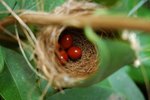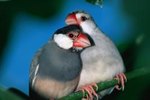Things You'll Need
Prefabricated finch or canary nests made of plastic, wood, wicker or bamboo
Fresh grasses
Dried grasses
Coco fiber
Tissue paper
Feathers: chicken, duck, pigeon, pheasant, quail
Burlap squares, loose-woven, small enough to be picked apart into 2- to 3-inch-long threads
Gardening twist-ties
Finches do not make nests for shelter; their natural behavior is to live in shrubbery and trees. The only reason finches build or adopt a nest is when they are in the mood to make little finches. They mate and lay eggs in the spring and fall seasons. Some finches mate during both these seasons; most nest once a year. In the wild finches seek out grasses and small, lightweight nest-building materials like feathers, plant material and bark. Some aviculturists breed and raise finches, housing them in cages or aviaries tall enough for a human to walk in. Enthusiasts can set out ready-made nests for wild finches to use, equip cages and aviaries with nests or provide their birds with the species' preferred natural building materials and let them make their own nests.
Gather together nest-building materials. Finches prefer nests made from natural materials. Fresh or dried grasses, coco fibers pulled apart, shredded tissue paper, soft feathers and burlap squares with an open weave that can be picked apart into threads all make good nesting materials.

Take a ready-made finch nest and layer it with the materials you have chosen, ending with a soft layer of feathers. Prefabricated nests can be plastic square-shaped, square wooden nests or cup-like wicker or bamboo.
Place your finch nest in the crook of a tree, among the leaves of a shrub or bush, in the upper corner of a cage (allow at least 20 inches of space in a cage for your finch to exercise) or attach it the upper walls of your aviary. If necessary, secure it in place with gardening twist-ties.
Clean the nest out when your wild finches move on or your pet finch nestlings develop their adult plumage. Throw away the dirty nesting materials and wash out the interiors with a mild soap and hot water. Wooden and plastic nests should withstand several seasons of nestlings. Even the light-weight bamboo or wicker nests can be re-used if they are thoroughly cleaned. Nests and nesting materials can be purchased online from suppliers like Pet Discounters (petdiscounters.com/Nests-and-Nesting-Materials_c_2345.html).
Tips
Add a cuttlebone to your finch's cage or aviary to provide it with calcium. Place a swing and perches inside your finch's cage. Provide fresh water or a drinking tube, and change it daily. Provide your finches with millet seed or sprays for feed, as well as spinach and grated fruit and vegetables.
Warnings
Do not use newspapers or wood shavings for nest-building materials as they can be toxic to your finches. Do not use brass cages as they can be toxic to some birds. Do not give finches yarn or thread for building nests as they can tangle them around their legs and injure themselves.
References
Photo Credits
-
Jupiterimages/Photos.com/Getty Images
Writer Bio
Michigan resident Mary Simms began her journalism career in 1985 as a Foreign News Desk sub-editor at "The Japan Times," one of Tokyo's English-language daily newspapers. In the U.S., Simms has worked as a reporter, business magazine writer and copy editor. She was awarded a Master of Arts in area studies/Near East in 1983 at the Monterey Institute of International Studies.




